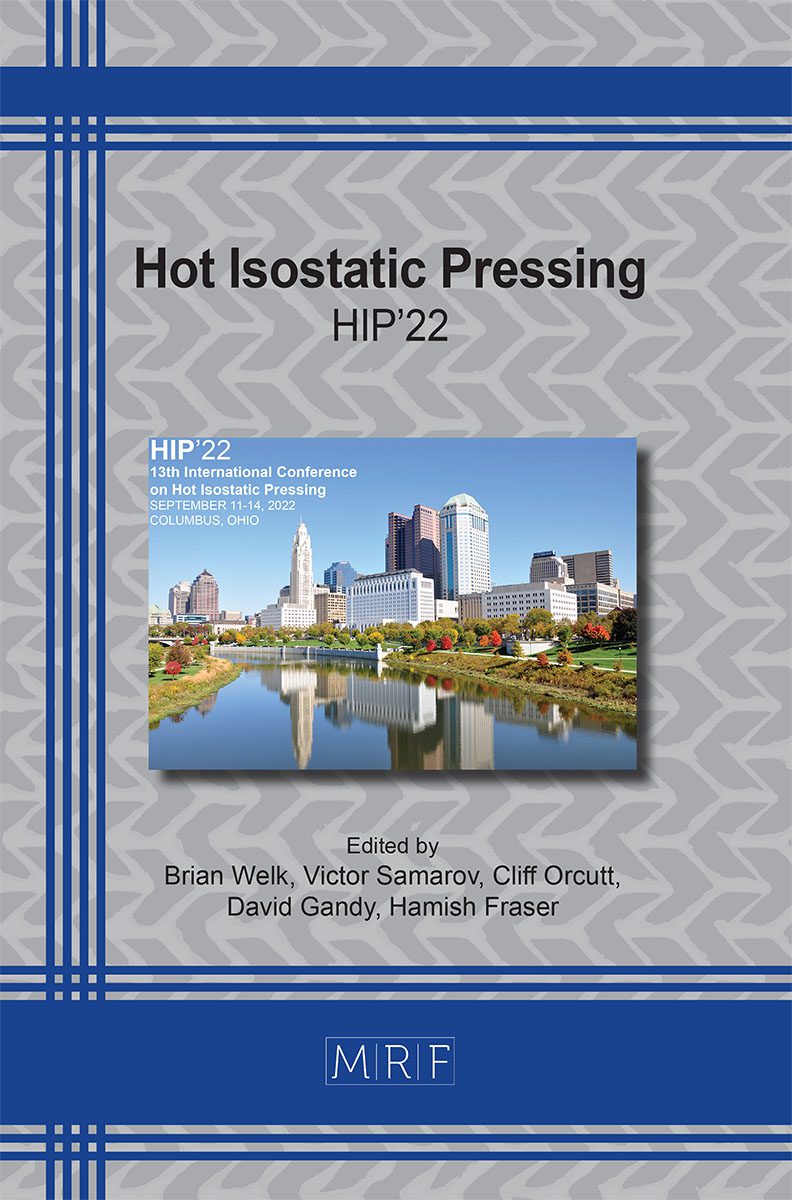Modelling of Powder Filling of HIP Canisters
Simon Chung, Abheek Basu, Kieren Irvine, Peter Wypych, David Hastie, Andrew Grima, Sam Moricca
download PDFAbstract. Hot-isostatic pressing (HIPing) of powders is achieved by placing them inside a canister, which is then evacuated and sealed. Canister filling is a critical step. Consistency in powder packing in the canister and increases in packing density will improve process efficiency and the predictability of HIP canister collapse, leading to less wastage. Understanding the effect of powder morphology, properties and characteristics on the can filling process and subsequent compaction is vital to optimizing canister design and the filling system. Conventionally, this has involved conducting numerous costly and time-consuming trial-and-error experiments. Computational modelling offers an alternative optimization path. Discrete element method (DEM) simulation of a powder filling process has been developed by GRI Inc. and its application to the US Department of Energy’s radioactive Idaho calcine powders has been investigated. A comprehensive analysis of a non-radioactive simulant powder has been conducted. A DEM model was developed with validation of the model using experimental data obtained from the filling system development program.
Keywords
Hot Isostatic Pressing (HIP), Radioactive Waste, Discrete Element Method (DEM), Powder Filling, Idaho Calcine Simulant
Published online 12/8/2023, 10 pages
Copyright © 2023 by the author(s)
Published under license by Materials Research Forum LLC., Millersville PA, USA
Citation: Simon Chung, Abheek Basu, Kieren Irvine, Peter Wypych, David Hastie, Andrew Grima, Sam Moricca, Modelling of Powder Filling of HIP Canisters, Materials Research Proceedings, Vol. 38, pp 131-140, 2023
DOI: https://doi.org/10.21741/9781644902837-19
The article was published as article 19 of the book Hot Isostatic Pressing
![]() Content from this work may be used under the terms of the Creative Commons Attribution 3.0 license. Any further distribution of this work must maintain attribution to the author(s) and the title of the work, journal citation and DOI.
Content from this work may be used under the terms of the Creative Commons Attribution 3.0 license. Any further distribution of this work must maintain attribution to the author(s) and the title of the work, journal citation and DOI.
References
[1] M. W. A. Stewart, S. Moricca, P. G. Heath, S. Chung, and N. Hyatt, ‘The Evolution of Hot-Isostatic Pressing for the Treatment of Radioactive Wastes – 18276’, WM Symposia, Inc. United States, Jul. 01, 2018.
[2] M. D. Staiger and M. C. Swenson, ‘Calcined Waste Storage at the Idaho Nuclear Technology and Engineering Center’. Idaho Cleanup Project Core, Idaho Falls, ID (United States), Sep. 24, 2018. https://doi.org/10.2172/1492726
[3] S. bin Yeom, E. Ha, M. Kim, S. H. Jeong, S. J. Hwang, and D. H. Choi, ‘Application of the discrete element method for manufacturing process simulation in the pharmaceutical industry’, Pharmaceutics, vol. 11, no. 8. MDPI AG, Aug. 01, 2019. https://doi.org/10.3390/pharmaceutics11080414
[4] M. Sakai, ‘How should the discrete element method be applied in industrial systems?: A review’, KONA Powder and Particle Journal, vol. 2016, no. 33. Hosokawa Powder Technology Foundation, pp. 169–178, 2016. https://doi.org/10.14356/kona.2016023
[5] W. R. Ketterhagen, M. T. Am Ende, and B. C. Hancock, ‘Process modeling in the pharmaceutical industry using the discrete element method’, J Pharm Sci, vol. 98, no. 2, pp. 442–470, 2009. https://doi.org/10.1002/jps.21466
[6] O. Baran, A. DeGennaro, E. Ramé, and A. Wilkinson, ‘DEM simulation of a schulze ring shear tester’, in AIP Conference Proceedings, 2009, vol. 1145, pp. 409–412. https://doi.org/10.1063/1.3179948
[7] B. A. Staples, G. S. Pomiak, and E. L. Wade, ‘Properties of Radioactive Calcine Retrieved from the Second Calcined Solids Storage Facility at ICPP 4’, Mar. 1979. Accessed: Oct. 12, 2022. [Online]. Available: https://www.osti.gov/servlets/purl/6071676
[8] ‘ASTM D7891-15 Standard Test Method for Shear Testing of Powders Using the Freeman Technology FT4 Powder Rheometer Shear Cell’, ASTM International, vol. 04.09. Dec. 27, 2016. https://doi.org/10.1520/D7891-15
[9] A. P. Grima, ‘Quantifying and modelling mechanisms of flow in cohesionless and cohesive granular materials’, Doctor of Philosophy thesis, University of Wollongong, 2011. [Online]. Available: https://ro.uow.edu.au/theses/3425
[10] H. M. Beakawi Al-Hashemi and O. S. Baghabra Al-Amoudi, ‘A review on the angle of repose of granular materials’, Powder Technology, vol. 330. Elsevier B.V., pp. 397–417, May 01, 2018. https://doi.org/10.1016/j.powtec.2018.02.003
[11] J. P. Morrissey, S. C. Thakur, and J. Y. Ooi, ‘EDEM Contact Model: Adhesive Elasto-Plastic Model’, Jun. 2014.
[12] T. A. H. Simons, R. Weiler, S. Strege, S. Bensmann, M. Schilling, and A. Kwade, ‘A ring shear tester as calibration experiment for DEM simulations in agitated mixers – A sensitivity study’, in Procedia Engineering, 2015, vol. 102, pp. 741–748. https://doi.org/10.1016/j.proeng.2015.01.178
[13] J. Quist and M. Evertsson, ‘Framework for DEM Model Calibration and Validation’, Sep. 2015.
[14] J. P. Morrissey, J. Y. Ooi, K. Tano, and G. Horrigmoe, ‘An experimental and DEM study of the behaviour of iron ore fines’, Sep. 2012.
[15] J. P. Morrissey, J. Y. Ooi, and J. F. Chen, ‘A DEM study of silo discharge of a cohesive solid’, in In: Proceedings of Particle-Based Methods III Fundamentals and Applications – Particles, 2013, pp. 298–309.
[16] J. P. Morrissey, J. Y. Ooi, J. F. Chen, K. Tano, and G. Horrigmoe, ‘Experimental and discrete element modelling of cohesive iron ore fines’, in Proceedings of Particle-Based Methods III Fundamentals and Applications – Particles, 2013, pp. 224–235.
[17] S. C. Thakur, J. P. Morrissey, J. Sun, J. F. Chen, and J. Y. Ooi, ‘Micromechanical analysis of cohesive granular materials using the discrete element method with an adhesive elasto-plastic contact model’, Granul Matter, vol. 16, no. 3, 2014. https://doi.org/10.1007/s10035-014-0506-4
[18] S. C. Thakur, H. Ahmadian, J. Sun, and J. Y. Ooi, ‘An experimental and numerical study of packing, compression, and caking behaviour of detergent powders’, Particuology, vol. 12, no. 1, 2014. https://doi.org/10.1016/j.partic.2013.06.009
[19] ‘AS 3880:2017 Flow properties of coal’. Australian Standard, Aug. 30, 2017.
[20] S. Moricca and S. Chung, ‘WO2018169594 RADIOACTIVE GRANULAR DISPENSING DEVICE’. https://patentscope.wipo.int/search/en/detail.jsf?docId=WO2018169594&_cid=P21-L7N63R-39264-1
[21] C. O’Sullivan and J. D. Bray, ‘Selecting a suitable time step for discrete element simulations that use the central difference time integration scheme’, in Engineering Computations (Swansea, Wales), 2004, vol. 21, no. 2–4, pp. 278–303. https://doi.org/10.1108/02644400410519794












